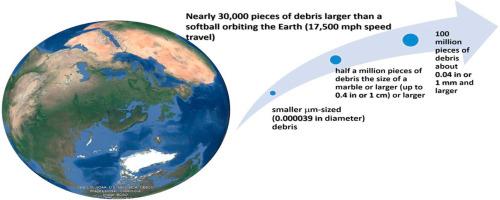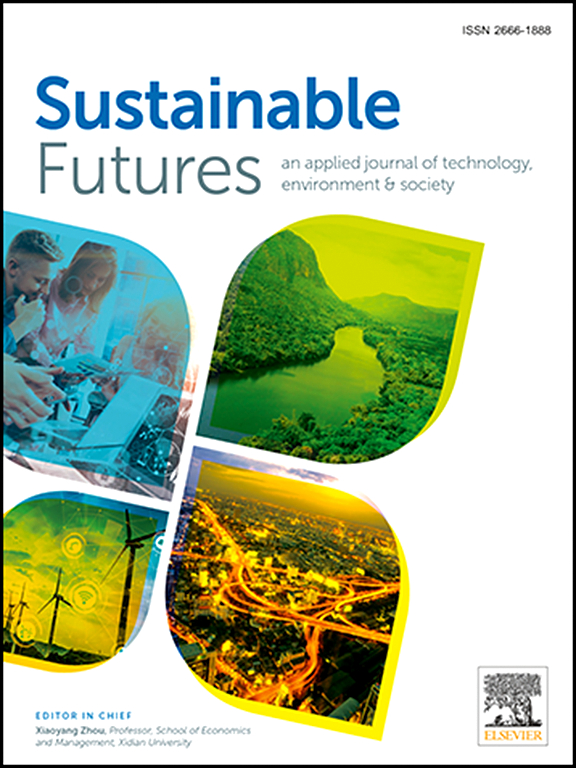管理空间碎片:风险、减缓措施和可持续性挑战
IF 4.9
2区 社会学
Q2 ENVIRONMENTAL SCIENCES
引用次数: 0
摘要
空间碎片由留在地球轨道或进入大气层的无功能人造物体组成,对空间操作构成重大挑战。目前的监控系统可以追踪到近4万个较大的碎片碎片,但据估计,数十万个较小的碎片和数百万个无法追踪的微小颗粒进一步增加了高速碰撞的风险。这些物体威胁到航天器的完整性、卫星的功能和空间活动的长期可持续性。这篇综述文章调查了空间碎片带来的危害,概述了其对卫星运行、载人航天任务和轨道稳定性的影响。报告审查了减轻风险战略,包括执行更严格的处置条例、在控制重返或脱离轨道的卫星设计方面取得进展,以及主动清除大型碎片物体。还探讨了空间碎片缓减的结构化方法,概述了拟议的四步战略:设计抗冲击航天器,实施先进的远程跟踪和监测系统,集成机载探测和规避机制,以及制定减缓冲击战略以尽量减少损害。此外,强调了加强跟踪技术和国际合作的重要性,因为需要集体努力来解决这一日益严重的问题。提高对日益增加的风险的认识和探索切实可行的减缓战略,可加强目前为保障空间活动和确保地球轨道环境的长期生存能力所作的努力。本文章由计算机程序翻译,如有差异,请以英文原文为准。

Managing space debris: Risks, mitigation measures, and sustainability challenges
Space debris consists of non-functional, human-made objects remaining in Earth's orbit or entering the atmosphere, creating significant challenges for space operations. Current surveillance systems track nearly 40,000 larger debris fragments, yet it is estimated that hundreds of thousands of smaller pieces and millions of tiny, untracked particles further contribute to the risk of high-velocity collisions. These objects threaten spacecraft integrity, satellite functionality, and the long-term sustainability of space activities. This review article investigates the hazards posed by space debris, providing an overview of its impact on satellite operations, crewed space missions, and orbital stability. It examines risk mitigation strategies, including the enforcement of stricter disposal regulations, advancements in satellite design for controlled re-entry or deorbiting, and the active removal of large debris objects. A structured approach to space debris mitigation is also explored, outlining a proposed four-step strategy: designing spacecraft for impact resistance, implementing advanced remote tracking and monitoring systems, integrating onboard detection and avoidance mechanisms, and developing impact mitigation strategies to minimize damage. Additionally, the importance of enhanced tracking technologies and international cooperation is underscored, as collective efforts are necessary to address this escalating issue. Increasing awareness of the growing risks and exploring practical mitigation strategies strengthens ongoing efforts to safeguard space activities and ensure the long-term viability of Earth's orbital environment.
求助全文
通过发布文献求助,成功后即可免费获取论文全文。
去求助
来源期刊

Sustainable Futures
Social Sciences-Sociology and Political Science
CiteScore
9.30
自引率
1.80%
发文量
34
审稿时长
71 days
期刊介绍:
Sustainable Futures: is a journal focused on the intersection of sustainability, environment and technology from various disciplines in social sciences, and their larger implications for corporation, government, education institutions, regions and society both at present and in the future. It provides an advanced platform for studies related to sustainability and sustainable development in society, economics, environment, and culture. The scope of the journal is broad and encourages interdisciplinary research, as well as welcoming theoretical and practical research from all methodological approaches.
 求助内容:
求助内容: 应助结果提醒方式:
应助结果提醒方式:


